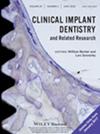The effect of contaminating media on the static and dynamic mechanical resilience of dental implant abutments' screws: In vitro study
Abstract
Introduction
This in vitro study aims to biomechanically evaluate the influence of medium contamination for example, saliva, blood, chlorhexidine (liquid and gel), and fluoride mouthwash on the biomechanical behavior of implant abutments' screws under static and dynamic loading.
Methods
Forty five Ti6Al4V commercial dental implants and abutments were tested in this study. Two main mechanical tests were carried out in the selected media. The first, static, aimed to evaluate the torque loss after the first tightening. The second, dynamic, involved a random cyclic load range between 0 and 200 N to evaluate torque loss due to mastication. In addition, metallographic longitudinal and cross-sections of the abutment-implant apparatus were examined to evaluate the abutment screw–abutment-implant interface.
Results
The static torque test showed that irrespective of the media, no statistical difference in static torque loss was found prior to dynamic loading. For the dynamic tests, torque-angle evolution analysis during tightening to 30 Ncm and after the spectrum loading, showed the same global mechanical behavior for all media, but the statistical analysis indicated a difference between the groups in reverse torque values (RTV) and in the torque loss due to dynamic loading. The medium groups CHX, CHX-gel, and Fluoride mouthwash, showed a meaningful torque loss due to loading, but the medium groups, control (no medium), blood and saliva showed an opposite trend and required a higher torque to open the abutment screws. The microstructural analysis revealed clear signs of cold-welding/galling, post-dynamic loading in these latter groups.
Conclusions
The presence of lubrication/contamination media (CHX mouthwash/CHX-gel/Fluoride mouthwash) reduces the preload generated due to tightening but prevents damage due to galling. The observed reduction of RTV clearly emphasizes the need for frequent abutment screw retightening for implant-supported prosthetic long-term stability.

 求助内容:
求助内容: 应助结果提醒方式:
应助结果提醒方式:


